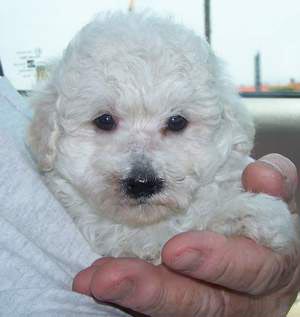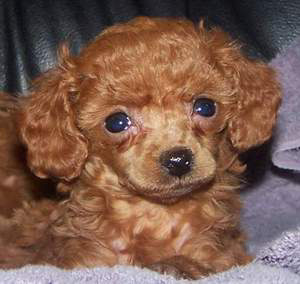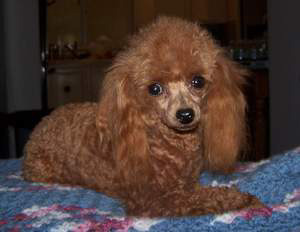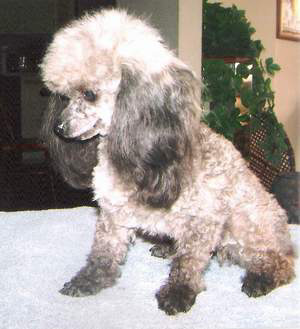
ABOUT TOY POODLES

The Toy Poodle
by Terry Thistlethwaite (printed with permission)
The name "Poodle" comes from the German word
"Puedin" which means "to splash in the water".
As a water spaniel related to the Portugese Water Dog,
this centuries old breed has been highly prized in
numerous cultures for their high intelligence, amazing
agility, high trainability, ruggedness, elegant beauty,
and loving personality. The breed was popularized by
traveling European performers who typically featured their
gleeful nature and athletic ability in all manner of shows,
circuses, and street performances. Royal command
performances featuring these incredible dogs clipped,
dressed, and groomed in all manner of presentation are
well documented throughout European history.
The "Continental Poodle show clip" originated as a
means of giving the dog the advantage of speed in the
water. Longer hair was left to cover the areas of vital
organs, head and ears, tail tip, and easily chilled
lower leg joints while the rest was shaved short much
the same as human speed swimmers will shave their body and leg hair even today. Even the bow in the topknot
had a functional purpose at the outset, in identifying the dog among others while he was working in the water.
Once the breed captured the interest of French nobility, it was quickly brought from the water to the palace,
where it was groomed and decorated as a fashion statement, and ultimately named "the national dog of France"
despite it's clear German origins. The French did much to bring the breed's popularity to even greater levels, and
even today there are many who mistakenly refer to the breed as the "French" Poodle, and ignorantly believe it's
origins to be as a "fru fru" dog and not the true working and sporting dog the breed's history truly attests.
Interestingly, the three size varieties of Poodle; Standard, Miniature, and Toy, have been established for as long
as the breed has been known. While some breeds existed for many years in a "large variety" only to be bred
down in size in more recent years, this is not true of the Poodle. Thus the Toy Poodle has as long and rich a
history as his larger sized brothers, the Standards and Miniatures.
The popularity of Poodles in all three size varietes continues on an international level today, and is very much a
credit to the breed's qualities of beauty, trainability, athleticism, and true versatility. Even unscrupolous sorts
breeding mixed breed dogs to promote the erroneous idea that there is some "superior" genetic claim for the
mutt (which they have re-termed the more ear pleasing "designer dog") typically rely on Poodles as a basis for
their wayward breeding programs. Touted as a "Poo / this" or a "that /Poo" their claim of a "better quality mutt"
is fully based on it's being related to a Poodle! It seems even breeders of falsely labelled mutts realize the
Poodle is a dog of justifyably high esteem!
Toy Poodles, like all toy sized breeds, require special
care. Toy dogs, despite the moniker, are, for example,
not for small children. Imagine living with a giant human
who typically behaves erratically, occasionally throws
objects that are larger than you are (balls, teddy bears,
etc.), jumps, skips about, makes all manner of loud
and squeeling noises, and is likely at any moment to
fall on you. Then ask yourself just how comfortable
you would be in such an environment. Even well
behaved and reasonably compassionate young children
cannot be expected to replicate the behavior of mature
adults on a day in and day out basis, nor should they.
A dog who is large enough to view them as "bumbling"
rather than "threatening" will be much more able to
take a comfortably protective rather than a terrified
defensive stance toward them, and therefore is a
much better choice for a small child.
Women who own toy dogs are often disparaged to
learn that their male friends who are obsessed with
making a "macho" impression are uncomfortable
around diminuative canines. Extremely sensitive to
human attitudes, the toy dog responds defensively,
which typically results in exessive barking, hiding,
and ankle grabbing; behaviors that often incite the
response of abuse, and/or the dog being given up to
another home, or even a shelter or rescue.
Moreso than with most other breeds, a prospective
owner need seriously consider possible future
changes in lifestyle that may one day render their
little companion "unsuitable" or even homeless!
Toy dogs have tiny little bladders and need to have
"potty areas" readily available to them.
While Toy Poodles are exceptionally intelligent and
learn housebreaking quickly, they can not be expected
to perform beyond their physical capabilities in
"holding it" longer than their tiny systems will allow.
A small doggy door opening up to a safely fenced and
well covered outside area, or a washable or disposable
"potty pad" kept in a spot on the bathroom floor will help any toy dog maintain their natural instinct for cleanliness in their living area.
Health issues particular to toy dogs must be explained to every prospective owner. They have dental issues. Raw chicken and turkey necks must be supplied to them on a regular basis so that older puppies do not retain their baby teeth, and adult dogs do not come to require risky veterinary procedures. Collapsed trachea
can result from a number of situations including the insertion of a "trach tube" during surgery. All such situations are to be avoided when at all possible. Because their bodies are so small, there is little time to
act when a toy dog becomes ill. What would be a slight degree of dehydration, for example, in a larger dog,
can be a deadly situation for a toy breed. Also, while a larger breed dog may go a full day without eating, a
tiny toy can encounter hypoglycemia within a few hours of not eating, and this condition too can be deadly
in very short order. Toy sized dogs do not have the fat reserves of their larger cousins, and chill very easily.
Chill can quickly become pnemonia and a dead dog. Sweaters and coats, and even boots and stockings
can be lifesaving to such a small canine.



.Toy dogs are delicate. They require protection from
the cold and the elements much the same as a young
child. They can literally be killed by a jerk on the
collar, by being accidently stepped or sat on, or by
falling from the back of a sofa or the seat in a van.
Outside, even in a fenced area, they are vulnerable to
hawks, owls, snakes, and even many cats, not to
mention larger dogs. Sighthound breeds particularly
tend to view them as prey, and have been known to
snatch and kill one right from an owner's arms in an
instant. Accounts of Coyotes in urban areas snatching
a toy dog complete with his leash are sadly not
uncommon.
Ultimately, it must be remembered that all toy dogs were selectively bred primarily to be companions,
and for this reason they are genetically predisposed to have a very strong need and desire to be with
their people. Owners who work all day, vacation without their pets, disapprove of dogs on the furniture, or
have changing lifestyles are best advised not to choose a toy of any breed. That said, these little canines
are still dogs - requiring exercise, enjoying play, thriving on raw meat, and responding well to positive
training methods. They are not fashion accessories to be spending their days confined in a purse (as is a
current and ridiculous custom). They may be possessed of bravado, but they are nonetheless sensitive, delicate, and requiring of human companionship that is intense, empathetic, totally committed, and lifelong.